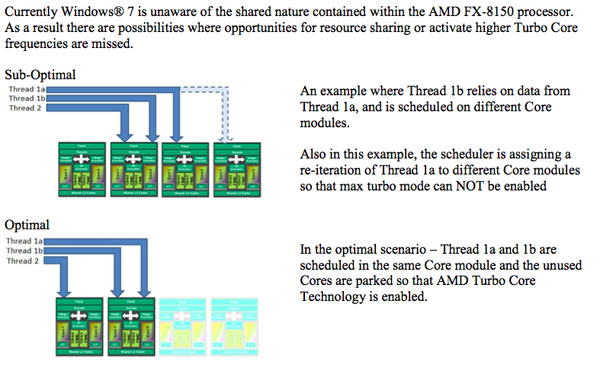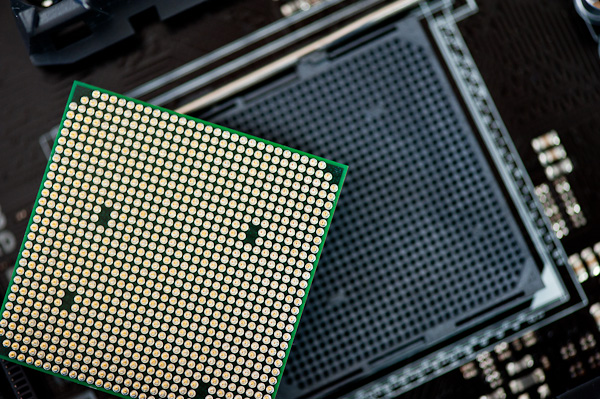The Bulldozer Review: AMD FX-8150 Tested
by Anand Lal Shimpi on October 12, 2011 1:27 AM ESTFinal Words
In many cases, AMD's FX-8150 is able to close the gap between the Phenom II X6 and Intel's Core i5 2500K. Given the right workload, Bulldozer is actually able to hang with Intel's fastest Sandy Bridge parts. We finally have a high-end AMD CPU with power gating as well as a very functional Turbo Core mode. Unfortunately the same complaints we've had about AMD's processors over the past few years still apply here today: in lightly threaded scenarios, Bulldozer simply does not perform. To make matters worse, in some heavily threaded applications the improvement over the previous generation Phenom II X6 simply isn't enough to justify an upgrade for existing AM3+ platform owners. AMD has released a part that is generally more competitive than its predecessor, but not consistently so. AMD also makes you choose between good single or good multithreaded performance, a tradeoff that we honestly shouldn't have to make in the era of power gating and turbo cores.
Bulldozer is an interesting architecture for sure, but I'm not sure it's quite ready for prime time. AMD clearly needed higher clocks to really make Bulldozer shine and for whatever reason it was unable to attain that. With Piledriver due out next year, boasting at least 10-15% performance gains at the core level it seems to me that AMD plans to aggressively address the shortcomings of this architecture. My only concern is whether or not a 15% improvement at the core level will be enough to close some of the gaps we've seen here today. Single threaded performance is my biggest concern, and compared to Sandy Bridge there's a good 40-50% advantage the i5 2500K enjoys over the FX-8150. My hope is that future derivatives of the FX processor (perhaps based on Piledriver) will boast much more aggressive Turbo Core frequencies, which would do wonders at eating into that advantage.

AMD also shared with us that Windows 7 isn't really all that optimized for Bulldozer. Given AMD's unique multi-core module architecture, the OS scheduler needs to know when to place threads on a single module (with shared caches) vs. on separate modules with dedicated caches. Windows 7's scheduler isn't aware of Bulldozer's architecture and as a result sort of places threads wherever it sees fit, regardless of optimal placement. Windows 8 is expected to correct this, however given the short lead time on Bulldozer reviews we weren't able to do much experimenting with Windows 8 performance on the platform. There's also the fact that Windows 8 isn't expected out until the end of next year, at which point we'll likely see an upgraded successor to Bulldozer.

So what do you do if you're buying today? If you have an existing high-end Phenom II system, particularly an X4 970 or above or an X6 of any sort, I honestly don't see much of a reason to upgrade. You're likely better off waiting for the next (and final) iteration of the AM3+ lineup if you want to stick with your current platform. If you're considering buying new, I feel like the 2500K is a better overall part. You get more predictable performance across the board regardless of application type or workload mix, and you do get features like Quick Sync. In many ways, where Bulldozer is a clear win is where AMD has always done well: heavily threaded applications. If you're predominantly running well threaded workloads, Bulldozer will typically give you performance somewhere around or above Intel's 2500K.
I was hoping for Bulldozer to address AMD's weakness rather than continue to just focus on its strengths. I suspect this architecture will do quite well in the server space, but for client computing we may have to wait a bit longer for a more competitive part from AMD. The true culprit for Bulldozer's lackluster single-threaded performance is difficult to track down. The easy answer would seem to be clock speed. We've heard of issues at Global Foundries and perhaps Bulldozer is the latest victim. If AMD's clock targets were 30% higher than Phenom II, it simply didn't make them with the FX-8150. I've heard future derivatives will focus more on increasing IPC indepedent of process technology and clock speed, but if you asked me what was the one limit to success I would say clock speed. As a secondary factor, AMD appeared to make some tradeoffs to maintain a reasonable die size at 32nm. Even then Bulldozer can hardly be considered svelte. I suspect as AMD is able to transition to smaller transistor geometries, it will be able to address some of Bulldozer's physical shortcomings.
The good news is AMD has a very aggressive roadmap ahead of itself; here's hoping it will be able to execute against it. We all need AMD to succeed. We've seen what happens without a strong AMD as a competitor. We get processors that are artificially limited and severe restrictions on overclocking, particularly at the value end of the segment. We're denied choice simply because there's no other alternative. I don't believe Bulldozer is a strong enough alternative to force Intel back into an ultra competitive mode, but we absolutely need it to be that. I have faith that AMD can pull it off, but there's still a lot of progress that needs to be made. AMD can't simply rely on its GPU architecture superiority to sell APUs; it needs to ramp on the x86 side as well—more specifically, AMD needs better single threaded performance. Bulldozer didn't deliver that, and I'm worried that Piledriver alone won't be enough. But if AMD can stick to a yearly cadence and execute well with each iteration, there's hope. It's no longer a question of whether AMD will return to the days of the Athlon 64, it simply must. Otherwise you can kiss choice goodbye.











430 Comments
View All Comments
Hrel - Wednesday, October 12, 2011 - link
yes, I use it as a term that means being cheap. My friends often call me jewish cause I hunt for bargains pretty relentlessly.silverblue - Friday, October 14, 2011 - link
I get called Scottish for the same thing. ;)poohbear - Wednesday, October 12, 2011 - link
so disappointing to read this. What on earth were they doing all this time?? AMD's NEW cpu can't even outperform its OLD CPU? well atleast i can stick with my PhenomII X6 till Ivy Bridge comes out & thank goodness i didnt buy a pricey AM3+ before reading reviews.:p So sad to see AMD has come to this.....OutsideLoopComputers - Wednesday, October 12, 2011 - link
I think when Anand publishes benchmarks with a couple of Bulldozers working together in a dual or quad-socket board (Opteron), THEN we will see why AMD designed it the way they did. If the FX achieves parity and sometimes superiority in heavily multithreaded apps vs Sandy Bridge in a single socket, then imagine how two or four of these working together will do in server applications vs Sandy Bridge Xeon. I'll bet we see superiority in most server disciplines.I don't think this silicon was designed to go after Intel desktop processors, but to perform directly with dual and quad socket Xeon.
Its intended to be an Opteron right now, and as an afterthought-to be sold as an FX desktop single socket part, to bridge the gap between A-series and Opteron.
JohanAnandtech - Wednesday, October 12, 2011 - link
Indeed. The market for high-end desktop parts is very small, with low margins, and shrinking! The mobile market is growing, so AMD A6 en A8 CPUs make a lot more sense.The server market keeps growing, and the profit margins are excellent because a large percentage of the market wants high end parts (compare that to the desktop market, where almost every one wants the midrange and budgets). the Zip and crypting benchmarks show that Bulldozer is definitely not a complete failure. We'll see :-)
g101 - Wednesday, October 12, 2011 - link
Good to see an intelligent reviewer that knows how to do more than run synthetic benchmarks and games.It's funny seeing all the uneducated gamer "complete failure" comments.
bassbeast - Thursday, February 9, 2012 - link
I'm sorry but you are wrong sir and here is why: They are marketing this chip at the CONSUMER and NOT the server, which makes it a total Faildozer.If they would have kept P2 for the consumer and kept BD for the Opteron then you sir would have been 100% correct, but by killing their P2 they have just admitted they are out of the desktop CPU business and for a company that small that is a seriously DUMB move. Their Athlon and P2 have been the "go to" chip for many of us system builders because it gave "good enough" performance in the apps that people use, but Faildozer is a hot pig of a chip that is worse for consumer loads in every. single. way. over the P2.
I'm just glad i bought an X6 when i did, but when i can no longer get the P2 and Athlon II for new builds i'll be switching to intel, the BD simply is worthless for the consumer market and NEVER should have been marketed to it in the first place! so please get off your high horse and admit the truth, the BD chip should have never been sold for anything but servers.
haplo602 - Wednesday, October 12, 2011 - link
This is a server CPU abused for the desktop.Have a look at FPU performance. Almost clock for clock (3.3G vs 3.6G) it beats 6 FPU units in Phenom X6. That's quite nice.
Once they do some optimisations on a mature process, this will achieve SB performance levels. However until then I am going for 2389 optys ....
GourdFreeMan - Wednesday, October 12, 2011 - link
You introduce the fact that AMD lengthened the pipeline transitioning to Bulldozed without explicitly mentioning the pipeline length. How many stages exactly is Bulldozer's pipeline?duploxxx - Wednesday, October 12, 2011 - link
Well there clearly seems to be something wrong with the usage of the modules in combination with the way to high latency on any cache and memory. single threaded performance is hit by that and so does lack any gaming performance.So I hope anandtech can have a clear look at the following thread and continue to seek further:
http://www.xtremesystems.org/forums/showthread.php...
secondly during OC just like previous gen, do something more with NB oc in stead of just upping the GHZ, there is more to an architecture then just the ghz....